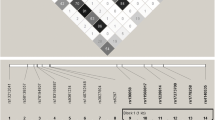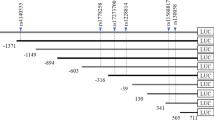Abstract
Serotonin (5-hydroxytryptamine) functions as a neurotransmitter and a hormone. Its diverse actions are mediated by at least seven distinct cell surface receptor subtypes. The serotonin receptor subtype 2 (gene symbolHTR2) is a G-protein-coupled receptor, expressed primarily in the cerebral cortex, where upon stimulation it stimulates the hydrolysis of inositol phospholipids. We have mapped theHTR2 locus to human chromosome 13 and to mouse chromosome 14 by somatic cell hybrid analysis. Linkage studies in CEPH families, using a PvuII RFLP detected with the HTR2 probe, revealed tight linkage betweenHTR2 andESD, the locus for esterase D. The most likely position forHTR2 is betweenESD andRB1, the retinoblastoma-1 gene. The homologous loci in mouse,Rb-1 andEsd(Es-10) are on mouse chromosome 14, close toag, agitans, a recessive neurological mutation. Having mappedHtr-2 to mouse chromosome 14, we predict that it falls into this known conserved gene cluster.
Similar content being viewed by others
Literature cited
Osborne, N.N. (1982). InBiology of Serotonergic Transmission (ed.) Osborne, N.N. (John Willey & Sons, Chichester), pp. 7–27.
Peroutka, S.J. (1988).Annu. Rev. Neurosci. 1145–60.
Richardson, B.P., and Engel, G. (1986).Trends Neurosci. 9424–428.
Frazer, A., Maayani, S., and Wolfe, B. (1990).Annu. Rev. Pharmacol. Toxicol. 30307–348.
Derkach, V., Suprenant, A., and North, R.A. (1989).Nature 339706–709.
Conn, P.J., Sanders-Bush, E., Hoffman, B.J., and Hartig, P.R. (1986).Proc. Natl. Acad. Sci. U.S.A. 834086–4088.
de Courcelles, D., Leysen, J., DeClerck, F., Van Belle, H., and Janssen, P. (1985).J. Biol. Chem. 2607603–7608.
DeVivo, M., and Maayani, S. (1986).J. Pharmacol. Exp. Ther. 238248–253.
Dumuis, A., Bouhelal, R., Sebben, M., Cory, R., and Bockaert, J. (1988).Mol. Pharmacol. 34880–887.
Pritchett, D.B., Bach, A.W.J., Wozny, M., Taleb, O., Toso, R.D., Shih, J.C., and Seeburg, P.H. (1988).EMBO J. 74135–4140.
Julius, D.J., Huang, K.N., Livelli, T., Axel, R., and Jessell, T. (1990).Proc. Natl. Acad. Sci. U.S.A. 87928–932.
O'Dowd, B.F., Lefkowitz, R.J., and Caron, M.G. (1989).Annu. Rev. Neurosci. 1267–83.
Kobilka, B.K., Frielle, T., Collins, S., Yang-Feng, T., Kobilka, T.S., Francke, U., Lefkowitz, R.J., and Caron, M.G. (1987).Nature 32975–79.
Sundaresan, S., Yang-Feng, T.L., and Francke, U. (1989).Somat. Cell Mol. Genet. 15465–469.
Francke, U., Yang-Feng, T.L., Brissenden, J.E., and Ullrich, A. (1986). InMol. Biol. Homo Sapiens, Cold Spring Harbor Symp. Quant. Biol. 51855–866.
Feinberg, A., and Vogelstein, B. (1983).Anal. Biochem. 1326–13.
Feder, J., Yen, L., Wijsman, E., Wang, L., Wilkens, L., Schroder, J., Spurr, N., Cann, H., Blumenberg, M., and Cavalli-Sforza, L. (1985).Am. J. Hum. Genet. 37635–649.
Hsieh, C.-L., Sturm, R., Herr, W., and Francke, U. (1990).Genomics 6666–672.
Ott, J. (1974).Am. J. Hum. Genet. 26588–597.
Lathrop, G., Lalouel, J.-M., Julier, C., and Ott, J. (1984).Proc. Natl. Acad. Sci. U.S.A. 813443–3446.
Lathrop, G., Lalouel, J.M., Julier, C., and Ott, J. (1985).Am. J. Hum. Genet. 37482–498.
Bowcock, A., Farrer, L., Hebert, J., Agger, M., Bale, A., Buys, C., James, D., Donis-Keller, H., and Cavalli-Sforza, L. (1989).Cytogenet. Cell Genet. 51966.
Bowcock, A.M., Farrer, L.A., Cavalli-Sforza, L.L., Hebert, J.M., Kidd, K.K., Frydman, M., and Bonne-Tamir, B. (1987).Am. J. Hum. Genet. 4127–35.
Ward, P., Packman, S., Loughman, W., Sparkes, M., Sparkes, R., McMahon, R., Gregory, T., and Ablin, A. (1984).J. Med. Genet. 2192–95.
Blanquet, V., Turleau, C., Creau-Goldberg, N., Cochet, C., and De Grouchy, J. (1987).Hum. Genet. 76102–105.
Duncan, A.M.V., Morgan, C., Gallie, B.L., Philips, R.A., and Squire, J. (1987).Cytogenet. Cell Genet. 44153–157.
Harper, P.S., Frezal, J., Ferguson-Smith, M.A., and Schinzel, A. (1989).Cytogenet. Cell Genet. 51562–611.
Ritvo, E.R., Mason-Brothers, A., Menkes, J.H., and Sparkes, R.S. (1988).Arch. Gen. Psychiatr. 45600.
Hsieh, C.-L., Lee, W.-H., Lee, E.Y.-H.P., Killary, A.M., Lalley, P.A., and Naylor, S.L. (1989).Somat. Cell Mol. Genet. 15461–464.
Womack, J.E., Davisson, M.T., Eicher, E.M., and Kendall, D.A. (1977).Biochem. Genet. 15347–355.
Stone, J.C., Crosby, J.L., Kozak, C.A., Schievella, A.R., Bernards, R., and Nadeau, J.H. (1989).Genomics 570–75.
Samuelson, L.C., and Farber, R.A. (1985).Somat. Cell Mol. Genet. 11157–165.
Hoecker, G., Martinez, A., Markovic, S., and Pizzaro, O. (1954).J. Hered. 4510–14.
Author information
Authors and Affiliations
Rights and permissions
About this article
Cite this article
Hsieh, C.L., Bowcock, A.M., Farrer, L.A. et al. The serotonin receptor subtype 2 locusHTR2 is on human chromosome 13 near genes for esterase D and retinoblastoma-1 and on mouse chromosome 14. Somat Cell Mol Genet 16, 567–574 (1990). https://doi.org/10.1007/BF01233097
Received:
Issue Date:
DOI: https://doi.org/10.1007/BF01233097




